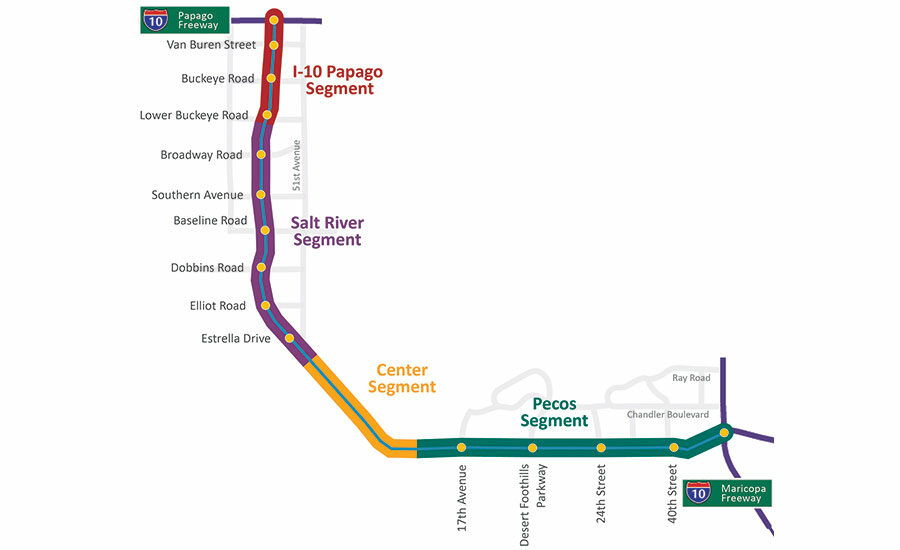Construction Revs Up on P3 Freeway in Phoenix

Workers erect mechanically stabilized earth walls adjacent to columns as part of the Loop 202 project in west Phoenix.
PHOTO COURTESY OF ARIZONA DEPT. OF TRANSPORTATION

Workers erect mechanically stabilized earth walls adjacent to columns as part of the Loop 202 project in west Phoenix.
MAP COURTESY OF ARIZONA DEPT. OF TRANSPORTATION


Now that construction has finally begun, crews are making rapid progress on the long-planned Loop 202 freeway in metropolitan Phoenix. The project features an incentivized approach to right-of-way acquisition and a non-linear construction schedule that will build last the center portion of the $1.7-billion project.
Also known as the South Mountain Freeway, Loop 202 will add a 22-mile connection to the eastern and western portions of metro Phoenix to relieve pressure on existing freeway corridors and local streets.
The Arizona Dept. of Transportation in December 2015 selected design-build-maintain entity Connect 202 Partners under the state’s first public-private-partnership agreement on a highway project. The joint venture brings together Fluor, Granite Construction and Ames Construction, plus maintenance contractor DBi Services. Lead designer Parsons Brinckerhoff is working with AZTEC Engineering, Stanley Consultants, Kleinfelder Group and AMEC. The P3 includes a 30-year maintenance contract.
Ongoing Right-of-Way Acquisition
Connect 202 Partners says contractors began work in September and have completed 22% of the project in terms of design, construction, right-of-way acquisition and utilities. The P3, which manages both construction and right-of-way acquisition, is in the final stages of acquiring residential and commercial properties.
Design should be finished by August or September, says Walter J. Lewis, Connect 202 project manager.
To date, ADOT and Connect 202 Partners have completed negotiations on acquiring more than 270 parcels, with 92 parcels left to be acquired, says Dustin Krugel, ADOT public information officer.
“One item that is unique on this project is incentivizing procurement to mitigate the right-of-way component. If we minimize the right-of-way footprint, the state ends up sharing on the right-of-way savings,” Lewis says. The 1,387 acres acquired as of April represent 90% of the total area needed.
So far, crews have begun median work at I-10 and construction near Elliot Road and the Salt River. “We’d like to be farther along, but are restrained by right-of-way,” Lewis says.
The freeway includes the state’s first use of diverging diamond interchanges to reduce right-of-way space and increase efficiency at intersections.
The freeway’s center portion—about five miles—will skirt over a portion of South Mountain and be built last, mainly due to ongoing litigation, according to ADOT and Connect 202 Partners.
Krugel says the 9th U.S. Circuit Court of Appeals in San Francisco is expected to make a final decision in mid-2018.
Construction will not begin unless the court rules to allow it.
As of now, ADOT and Connect 202 Partners have not made contingency plans in case the court orders against construction. Earlier this year, that same court rejected the Gila River Indian Community’s motion for an injunction, pending appeal.
If completed as planned in 2019, the freeway will have four lanes in each direction, including an HOV lane. Crews will excavate more than 10 million cu yd of earth and construct about 40 bridges, substantially less than previously estimated.
Construction comprises $916 million of the total cost, while $572 million will pay for rights-of-way, says Rob Samour, ADOT project manager. The remaining budget will pay for utilities and construction engineering. Routine maintenance will cost around $3 million annually.
The freeway was first proposed as part of the region’s transportation plan in 1985. Since then, all the other freeways in the plan have been completed.




